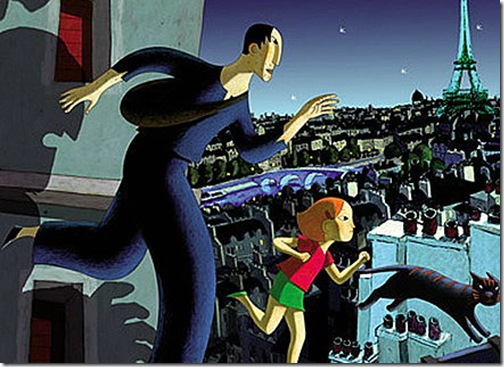In just over three minutes, the short film The Extinction of the Saber Tooth Housecat, which precedes the animated feature film A Cat in Paris in its theatrical run, marvels with the unfettered joy of filmmaking.
There is no dialogue, just an animated feline frolicking through a pristine, real-life field, while a meteor hurtles through space. The quickening editing scheme is thus: cat, meteor, cat, meteor, cat, meteor, until meteor konks cat on noggin. Expressing the wonders of suspenseful cross-cutting with the ardor of a film pioneer and ending this exquisite live-action/animation hybrid on a deadpan note of humor, The Extinction of the Saber Tooth Housecat is a perfect little film, setting up a nigh impossible standard for the feature that follows it.
Indeed, the appetizer is far more satisfying than the main course. Nominated for Best Animated Feature Film at the Oscars this year (considering the category, it’s not saying much), A Cat in Paris has moments of innovation that rival this short, but they’re at the service of hare-brained, eye-rolling content.
It’s about a girl named Zoe, the youngest of the film’s oval-headed residents, who has suffered from selective mutism ever since after her policeman father was killed by gangsters (sounds good so far, right?). Her mother, the local police superintendent, searches for her husband’s killer with exhausted tenacity while neglecting her daughter at home; Zoe’s only friend is her cat, which steals away every night to help a petty thief swipe jewelry and antiques from sleeping Parisians (still sounds good).
When directors Jean-Loup Felicioli and Alain Gagnol’s cameras focus on the cat’s nocturnal journeys, the film seems to appreciate the obstinacy, intellect and self-sufficiently of felines. It’s too bad his characters have to start talking. It isn’t long before the story lets its dramatic potency acquiesce to hackneyed stereotypes: A bumbling cadre of gangsters, a grizzled, rule-breaking antihero and a malicious nanny propel the spartan plot forward simply by going through the motions. These characters are so thin they seem to lose dimensions right in front of the camera.
Felicioli and Gagnol do manage to pace their nonstop action enough so that the set-pieces, not the construction-paper characters, take up the most screen time. They stage the majority of the film’s movement on moonlit rooftops, creating a noirish, romantic playground for life-or-death drama, while the rest of the world sleeps. There’s an inspired moment involving some scaffolding and a sequence in which all of the color is blacked out from the frame, cleverly reducing its characters to white line drawings.
But these dazzling techniques are employed for … what, exactly? The dialogue – spoken in this American dub by Matthew Modine, Marcia Gay Harden and Anjelica Huston, among others – is limp and asinine, purely pandering to a pre-pubescent demographic. There are long stretches of A Cat in Paris that would be indistinguishable from most children’s programming on the Cartoon Network.
Forgive me for expecting a little more, but in this post-Pixar universe, shouldn’t we demand our children’s entertainment be layered with at least a modicum of smart dialogue and narrative sophistication? I’m not asking for profound allegories on aging and environmentalism. I’m not even asking for kids’ features to contain the bravura stylistic touches of The Extinction of the Saber Tooth Housecat.
I just want a film that adults can watch, too, without deadening their senses.
A CAT IN PARIS. Directors: Jean-Loup Felicioli and Alain Gagnol; Distributor: GKIDS; Rating: PG; Opens: Friday at Living Room Theaters in Boca Raton and Cinema Paradiso in Fort Lauderdale
